
Easter 2019 is coming up and Amazon is ramping up its Easter toy sales. Yesterday the giant retailer featured deals on fluffy plush pets and electronic pets. Today you can save on learning toys from...
Congratulations, you joined a Design School! It feels like you have conquered the world and you want to sample and learn all of it right away. But do keep in mind, these years can slip by faster than you can believe, and before you await your graduation, wondering where the time ran away, the tips below by Mydee Lasquite will teach you how to reflect, respond and absorb the max of your design schooling.
Recruiting a designer? Post a job with us to source the best talent for your requirement.
Looking to switch over to a freelance career? Check out YD Job Board to work with some of the best design companies in the world!
Organization
The most important thing a design student should learn and value is staying organized at all times, in all areas of learning. Calendar management is one. An ordinary calendar can serve as a planner. Detail everything on your calendar to help you keep track of everything you need to accomplish for each day, week, month or semester.
Use the calendar to keep track of deadlines and your project progress. Today’s smartphones, tablets, and computers come with calendars you can adjust to your personal preference. You can also download calendar applications and task reminders to help you make the most of your time.
You can end up falling behind and missing important assignments if you don’t list your deadlines in chronological order. Use your calendar to list assignments and their deadlines to get a better idea of how much time you need to set apart for each project.
Learn to stick to your deadlines and make it a point not to miss any assignment as this reflects your ability to meet expectations later on in your career.
Learn to Prioritize
Knowing when to study and when to party is a survival tip for any student. Think of it this way: You should have twice as much time for working on projects or assignments as you do for social activities. Design is a demanding area of study but also a rewarding career.
Learn to prioritize. This also applies to project and subject management. If you can determine which subjects needs more of your attention, then you can focus on those. Following this tip will also free up time for improving your performance in other classes.
Master the Art of Overestimation
Design requires time. A student in design should know early on that every project or assignment that will be required during the course of study cannot be done overnight. Most often than not, projects will be assigned ahead of time and will require days or even weeks and months to complete, depending on the difficulty of the subject matter.
Train yourself to overestimate the amount of time needed for each project. An important tip for design students is to never eyeball the amount of time you think you will need. If by chance you finish the project before your estimated time, then you will have extra time to do other things or review and improve what you have just completed.
When you land a career in design, you will find that overestimation will save you time, allow you to be detail-oriented and be more efficient in your responsibilities.
Establish Your Network
Design has various specializations. When you start working, you will find yourself needing the expertise of professionals from other areas. As of now, you can start reaching out to potential partners, friends and fellow designers who can assist you when you get your degree and establish your career.
Be friendly and make sure you get connected to people who in the future might be working for other agencies or specializing in other fields. Establish real connections, both for personal growth and your professional future.
Keep the Passion and Momentum
Design work is demanding and at some point may become frustrating. You can survive your studies by being passionate about your course work and enjoying every challenge. Passion fuels creativity, which is the most important requirement of design.
Ask yourself every now and then why you entered design school and keep reminding yourself of that reason. This will enable you to complete your studies with enthusiasm and become successful in your field.
Be and Stay Creative
In this post on tips for design students, we mentioned that the most important requirement is the ability to remain creative throughout your career. As a designer, your creative ability will be reflected in anything you produce. There may be times you will find your creativity will wane, but, there are ways you can maintain and improve creativity. You should be aware of this and never be afraid to accept that you are in need of inspiration and help coming up with ideas.
In the world of design, ideas are currency and without them, there is nothing you can offer. Always offer your ideas. If they are not welcomed, don’t get disappointed just yet. The world of design is as erratic as the world of marketing is, so keep those ideas flowing, store them and you may just need them in the future.
Be an Avid Learner
Learn as much as you can. Digest everything. Make the most of your time as a student in design. Learn from your classmates, team members, and your teachers. Get some inspiration from your peers’ ideas and store up everything you see and hear in your creativity arsenal–you never know when you might need it in the future. Use the Internet, your books and every situation you encounter. Explore and learn. Experience everything around you, including success and failures, and learn from them.
Never refrain from learning something new every day. Experience is the best teacher, and we can only be a failure if we stop learning what we fail to understand.
Invest in Your Portfolio
Invest time in building your portfolio. Learn how to handle your weaknesses and strengths. Collate your work and understand the reason why you have chosen certain pieces to form part of your portfolio. Knowing why will make it easier for you to answer why you have chosen a particular piece to showcase.
Be Open to Criticism
You are in design school for a reason: to learn. Expect your professors and peers to critique your creations. Sensitivity has no place in learning. Criticism is given to help you make better choices and come up with better ideas while you perfect your skill.
A critique is not a personal attack, but a meaningful way of telling you there is a room for improvement and that you can do better. A particular person’s opinion about your work is not the end of the world, nor does it make you a bad designer.
Avoid getting defensive when being given suggestions and feedback. Be open to what others have to say on how you can improve your work. Again, you can learn a lot from others.
Your work is created not only for your satisfaction but for your audience’s appreciation, hence it should be effective and beautiful in their eyes, even if it means disregarding your personal point of view and stepping out of your comfort zone.
Stay Up to Date with Design Trends
There are rules in design that are so basic that they still exist and are implemented to create harmonious and well-balanced creative projects.
And yet there are means and methods that are already classified as overused or ineffective. In a post on most overused design elements, we have provided a list of some of the most commonly used elements and techniques in design. They may still be good to use but in a rapidly and constantly changing world of visual design, one needs to learn new things and master their implementation to give a fresh and more contemporary presentation of visual elements and design.
Believe in Yourself
You can’t ask other people to value your work more than you do. How you see yourself will be reflected in your creations. It will also affect how you sell your work. If you don’t believe in yourself, you don’t believe in what you do and what it can produce, you will fail to sell it to others.
You have to understand that your time and effort is worth the price of your work. If you believe in yourself and value what you do, you will never be the prey of intimidation, and you will not be shaken by demeaning criticisms. Design is a competitive industry and you need to know how much you are worth and take pride in it so that other people will see and respect it.
Breathe and De-Stress
The design business is hectic. Stress and anxiety are normal emotions most people experience in this field. When you find yourself stuck and unable to generate ideas or find inspiration, take time to relax and calm yourself. Free yourself from overwhelming feelings and do whatever is necessary to get out of the funk. When you’re a student, you can push yourself to beyond your limits but take a break when something feels wrong or is not working right. This will help you regain peace of mind and give you a fresh eye. It can also offer a new perspective.
Designing is stressful, and you need to de-clutter and de-stress to give your creativity a chance to flourish.
Keep these tips for design students in mind while you are in school and it will make your studies much easier to complete. You will have more time to accomplish everything and have better chances of performing better and even graduating with honors. With these accomplishments, you will have a better chance of showcasing the quality of your work, standing out among your peers and landing a good job.
The original write up by Mydee Lasquite here.
It is said that first impressions matter. We spend hours going over every facet of our product design, trying to achieve the perfect version of it. And in all our efforts, we often skip out on one aspect – the packaging! The way we first see or greet a product is the moment we form our initial perception of it. This first moment is like a first date, you either hit it or miss it! But unless you do hit it, you may not get this chance again. To help you define the packaging better, the write-up below by Tabatha Johnson walks you through 12 tips that will help you craft the perfect packaging for your amazing product.
Looking to hire a talented designer? Post a job with us to source the best talent for your requirement.
Want an amazing internship or job opportunity? Check out YD Job Board to work at some of the best design companies in the world.
Designing a product is only the first step. No matter how great your shampoo smells, people won’t pop the lid and give it a whiff if the bottle doesn’t make them want to pick it up first. One of the easiest ways to get your product to sell itself is through attractive product packaging design.
But what makes great product packaging? Read on to find out twelve of the top tips for designing creative product packaging that does the job right.
Consumers are bombarded by products whenever they enter a store. When someone picks up your product, they want to find out two things: what it does and who makes it. If they can’t answer both in four seconds or less, which is usually the maximum time anyone will spend looking at a product, they move on to the next item on the shelf.
Part of making sure a customer understands what your product does is choosing a font they can actually read. Using all capital letters makes it harder for our brains to compute the information we are seeing. If your font is too swirly or fancy, customers may misread your label, which can be a career-ending mistake.
You also need to keep the font size in mind. If the text is too small, your customers might miss crucial information about your product. If the text is too big, the packaging can become loud and crowded.
Keep it simple. Trying to cram too much information onto your product’s packaging will remind customers of how they felt when they had to read chapters out of their biology textbook: bored and confused.
This also goes back to clarity. If all your customer can see on your product packaging is the listed benefits, but not your company name or the name of the product, you’ll be missing out on the possibility of future sales.
Your product packaging should represent what your product is and does. People can smell a salesman from a mile away and they can tell when packaging is overselling the product it contains. If your packaging shows something completely different than what is found inside, your customers won’t be happy.
A creative workaround for this problem is making part of your packaging transparent.
This tip may sound the same as honesty, but it’s different. In this case, the focus is on what your brand represents. This should come through when you sit down to design your product’s packaging.
Your brand is different from every other brand trying to sell the same thing, so let that show in the design of your product’s packaging. If your brand’s mission statement is about connectedness, you could incorporate a tear-away postcard into the packaging, so your customers can stay connected with their friends in a unique way.
This tip generally applies only if your product is available in a physical store, but it could still have an impact in an online shopping scenario too. The way products are presented and organized in stores means that your product will likely end up in a sea of others that also claim to do the same thing.
Your product needs to stand out from the others on the shelf. But how do you make it do that? The first rule is to know your competition.
If the other top-selling brand of raisins only uses red packaging, maybe you make yours in green instead. Another strategy that can work is to mimic your competition so closely that consumers will not notice when they pick up your product instead of theirs. This can backfire, though, so think it all the way through first.
Including creative, fun ideas and even some humor into your product packaging design will not go unnoticed or unappreciated. This invites consumers into the product and gives them a feeling of familiarity.
One company designed tea bags that look like t-shirts that also included a hanger design, so the teabags could easily hang on the edge of a mug. This design makes the product easier to use and is also sure to give customers a chuckle and keep them coming back.
Creating special limited editions of your packaging for a certain event or theme is one way to boost short-term sales very quickly. This tactic relies on consumers’ likelihood for impulse buying. This works around the holidays and it can be co-opted for big sporting events like the Olympics too.
In every industry, trends are what keep innovation alive and are necessary for the longevity of the market. While it’s true that trends fade with the times, they’re also circular and tend to come back around time and again.
While being able to predict the upcoming trends is a skill, everyone is able to keep up with trends as they appear if they’re paying attention.
In the many rules of product packaging design, the focus is often on how to grab the customer’s attention, but now we’re challenging you to think about the customer in a different way. Think about the way the customer is going to use your product. Is your custom product packaging design intuitive with how the product works?
Is your product good for only a one-time use, or is it something to be used over and over? If it’s only meant to be used once, make sure the packaging is easy to get into and dispose of. for disposable items is also worth bonus points for the eco-conscious consumer.
If your product is something that’s used over a long period of time, make sure the packaging is durable and will maintain the quality of the product inside. Even if they love the product, if your lip balm dries up after four uses, customers won’t repurchase it.
Something consumers have questioned for years is why cereal boxes are not resealable. This trend has yet to take off in the breakfast market, but when it does, consumers will know that the change was made with them in mind. There’s nothing a customer appreciates more than packaging that is both aesthetically pleasing and functional.
If your packaging is overly bulky, include handles or grooves to help with ease in carrying it. If your product is fairly small, make sure your packaging isn’t too slippery, so users aren’t dropping it. Unless your brand has a monopoly on the market, customers won’t stick around if they have too difficult a time handling the product.
This tip may feel like a copout, but trust me, it isn’t. When you’ve mastered the art of design for product packaging, you’ll begin to see that not all of the rules apply all the time. While these are all things to keep in mind, breaking the rules can be a good thing. In fact, breaking the rules is what will turn your brand into a trendsetter instead of a trend follower.
Following trends is a good place to start and break your way into the market, but once you’re an established presence, finding ways to break the rules of conventional product packaging design is what will set your product apart.
Whoever thought about flipping the ketchup bottle upside down was a genius and changed the rules of food product packaging for the rest of time. They still worked within the conventions of the product market, though. You can be sure that no one is designing square condiment bottles any time soon.
The best brands keep their eyes on the prize: expansion. Leaving room for your brand and product range to expand and grow is key for your business’s long-term success. So, remember this when you’re designing your product’s packaging.
That is not to say that you can’t be extremely specific when you’re designing the product packaging for a certain product. It just means that you need to be able to make variations to the design when your brand inevitably creates new products in the same line.
We may never know exactly what it is that makes customers pick one brand of something over another, but following these rules when you’re thinking of custom product packaging design can give you a head start over the competition.
The original write up by Tabatha Johnson here.
Our endeavor is to increase efficiency and speed by connecting you to your ideal candidates. Yanko Design has curated Industrial Design followers for the past 15+ years, and we know these are the best match for your company. To recruit now, Post a Job with us!
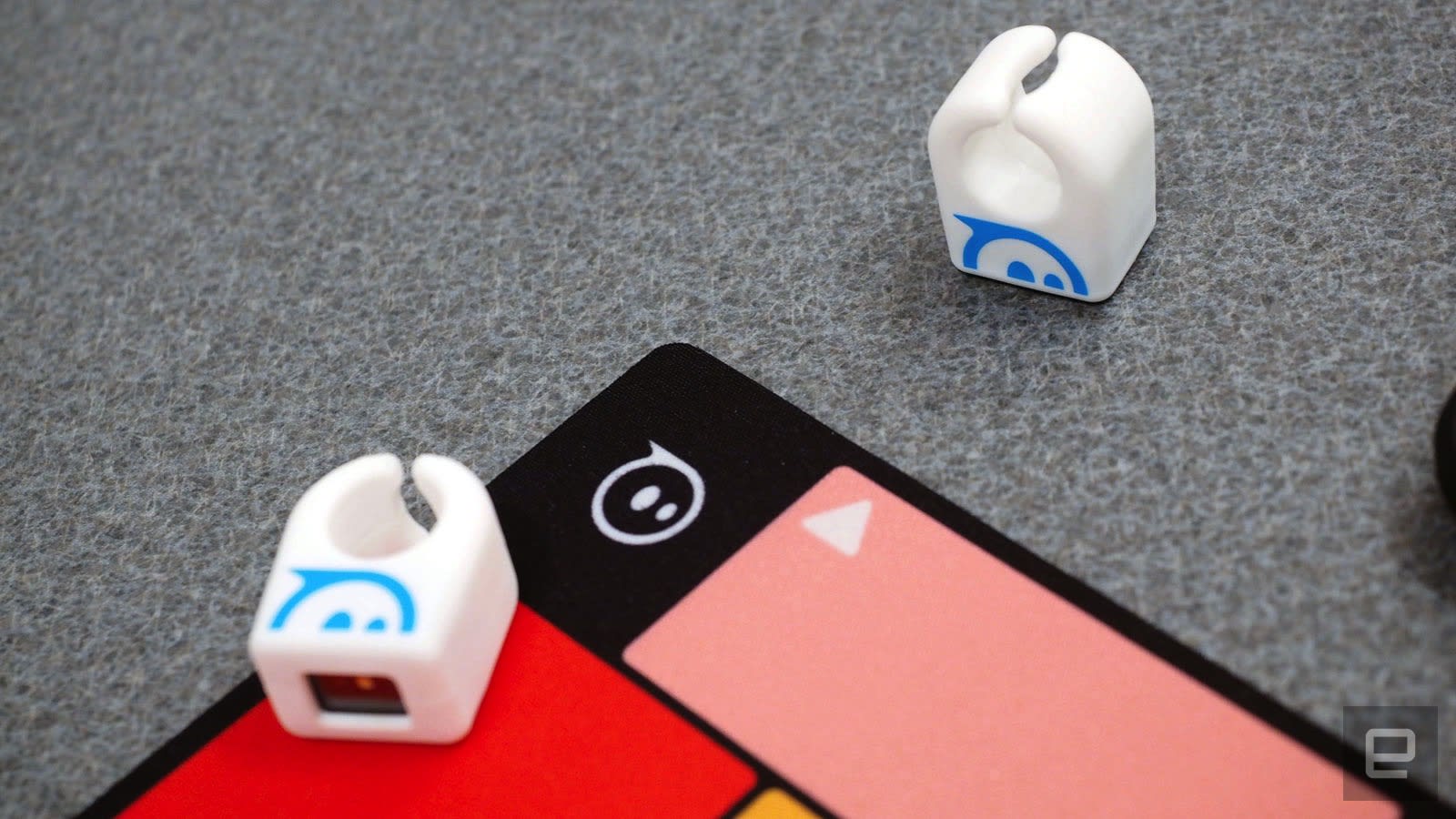 Back in June 2018, Sphero acquired Specdrums, a startup that found Kickstarter success with music-making rings. As part of that deal, we knew Sphero would be working on its own version of the product, and today the company's making it official. The n...
Back in June 2018, Sphero acquired Specdrums, a startup that found Kickstarter success with music-making rings. As part of that deal, we knew Sphero would be working on its own version of the product, and today the company's making it official. The n...
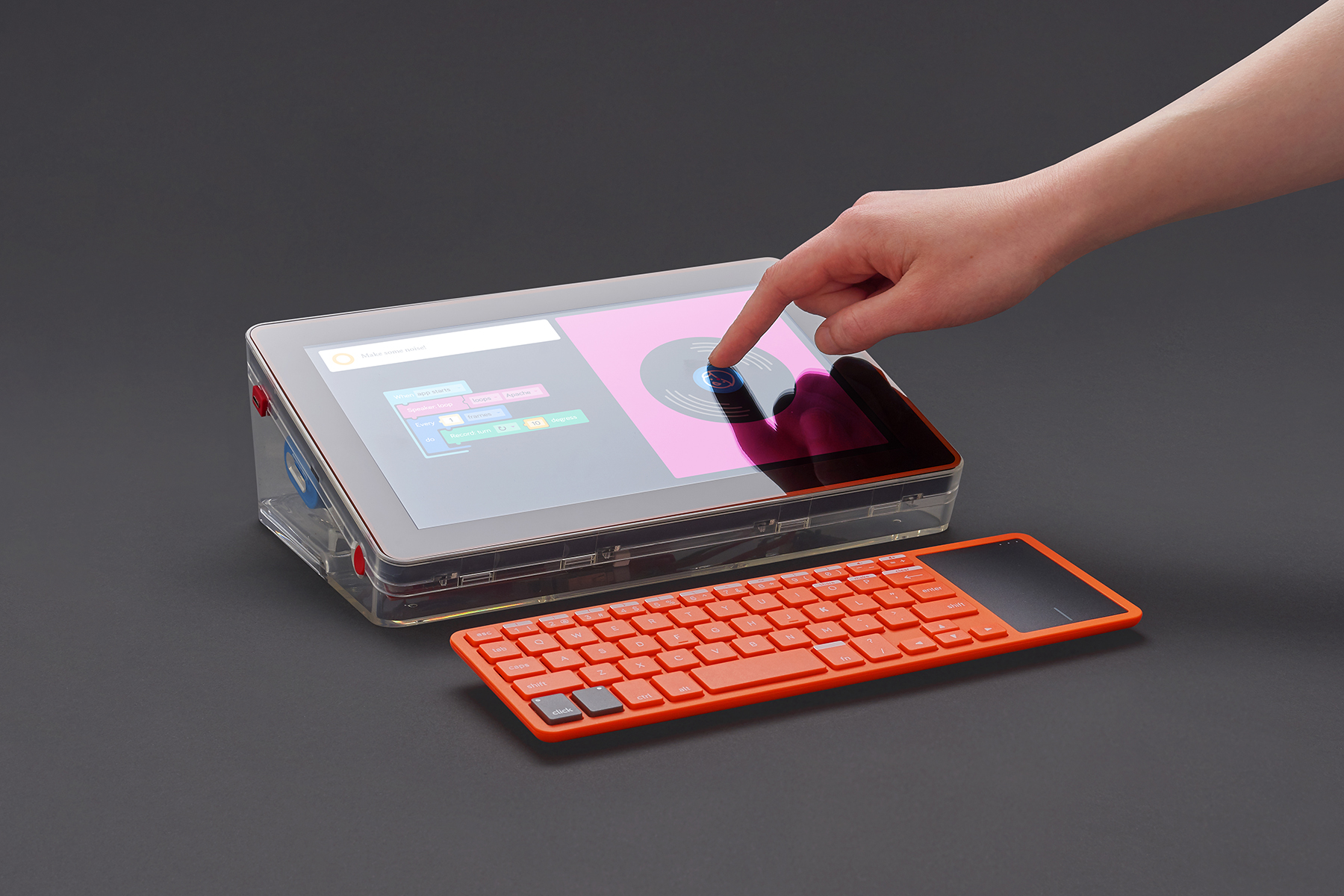 Twelve months ago, Kano unveiled a complete build-it-yourself computer kit powered by Raspberry Pi. It looked the part but ignored the fact that most children love tablets, smartphones, and other devices with a touchscreen display. Now, the company i...
Twelve months ago, Kano unveiled a complete build-it-yourself computer kit powered by Raspberry Pi. It looked the part but ignored the fact that most children love tablets, smartphones, and other devices with a touchscreen display. Now, the company i...
 LittleBits is introducing three new kits that teach children about electronics and how to think with a creative, inventive and activist mindset. The Base Inventor Kit, which will retail for $99.99, comes with 12 color-coded pieces that snap onto a we...
LittleBits is introducing three new kits that teach children about electronics and how to think with a creative, inventive and activist mindset. The Base Inventor Kit, which will retail for $99.99, comes with 12 color-coded pieces that snap onto a we...
Staring out in an industry and getting that first job is one of the biggest milestones for any professional. And entering the world of design requires a multitude of skills as well as a truly kick-ass portfolio that will blow the interviewers mind! But what if we don’t have a substantial portfolio? This question is addressed in the write-up below by Jonathan Courtney(Co-Founder of AJ&Smart) who gives some smart and unconventional tips that will definitely land you that job!
Still looking for a job? Check out Yanko Design Job Board to find an opportunity now.
Looking to hire a designer? You can post your requirement with YD Job Board to connect with our dynamic young professionals who are always on the lookout for fresh prospects.
It’s a classic chicken/egg problem!
You’ve just gotten out of University, you’re still in University, you’re changing careers, you’re just curious and you want to give Product Design or UX a go. There’s one problem though… you don’t have a portfolio, or you have one but it’s mostly side projects or fake projects, nothing that would excite anyone hiring for a design role. The other problem is, you don’t have a lot of connections, you don’t know how this whole tech and design world works, it’s dark, confusing and a bit intimidating.
Well, good news! I’m here to help. I’ve been a Product/UX guy for over 8 years, have had the pleasure to work with some of the biggest and best brands in the world, I’m buddies with design super-stars like Jake Knapp (he’s like the Brad Pitt of Silicon Valley), and now I run my own agency that hires Designers! Why do I want to help you? Because I want internet attention of course! Just kidding (please like, share, clap, subscribe, tweet, insta) — really I just want to help those willing to listen to find some of the shortcuts I wish I had known about.
Ok, enough blabbing! Here are my best tips on getting a job in Product Design! (If you don’t feel like reading, just watch this cheeky video myself and my lovely colleague, Brittni, made:)
1. Volunteer at Events (and be useful AF)
Goddamn it! This one is so obvious, but so few people get it. Getting a job is so much just about “being there” and building relationships with certain people. When you volunteer at events, for example a UX Meetup run by a company you want to work at, you’re basically giving yourself a foot in the door without having to be interviewed or going through the painful process of showing off your portfolio, which is likely not going to have any real projects in it anyway!
Everything in work-life is about relationships. Sure, skills are important, but they’re absolutely trumped by relationships. Volunteer at relevant events, meet and get to know relevant people and slowly you’ll start to find some great shortcuts into the places you’ve always wanted to work.
Now there is one caveat to this strategy: if you volunteer at an event, you need to completely overdo it in terms of being proactive and useful. You also need to be patient and build trust with employees at the companies you want to work at so it doesn’t come across that you’re desperate for a job. You want to seem curious (and you should be) about how the company works, what the culture is like, what their processes are.
The current AJ&Smart product team is full of people who I first met at our events!
At AJ&Smart, we’ve met some of our best employees and allies through volunteering, but it was always the people who went the extra mile, gave us insights we hadn’t thought of and in the end showed us that they have a great work ethic. I’ve seen too many volunteers who get the opportunity and then waste it by simply doing the basic tasks at hand and making no effort to take it a step further or even ask questions.

2. Canvas Strategy (a.k.a Make Other People Look Good)
This one is so simple and so obvious, yet so many people are so busy thinking about themselves when they look for a job that they forget that the people hiring them are also only thinking about themselves!
Making other people look good, removing obstacles for them, helping them make connections to people that they might find invaluable is the ultimate job hack. It doesn’t matter if you’re looking for something new or just looking to be promoted, the Canvas Strategy (which I first heard about from Ryan Holiday here) is a tried and true formula for accelerated success.
So, how about an example?
Let’s say you want to work at my agency. Now, we, like many product studios, get a lot of applications daily and it can be quite hard just to keep up with which candidates are interesting, which ones we should meet. Now let’s say I get an email from a candidate (who, maybe volunteered at a recent event  ) and let’s say this email is an introduction to someone at a company they know I want to work with, or maybe they figured out I’m trying to grow our Youtube channel and connect me with an influencer who wants to help. They’re not asking for a job yet, but they’re already creating value before I’m ever exposed to their design skills. They’re already building a relationship by making my life easier.
) and let’s say this email is an introduction to someone at a company they know I want to work with, or maybe they figured out I’m trying to grow our Youtube channel and connect me with an influencer who wants to help. They’re not asking for a job yet, but they’re already creating value before I’m ever exposed to their design skills. They’re already building a relationship by making my life easier.
This is so much more likely to turn into a coffee or a beer with me than the emails I receive asking if someone can “pick my brain”. Before you ask for something make sure you’re delivering some form of unconditional value.
Ryan Holiday outlined 3 great ways to get started with the Canvas Strategy here:
3 Keys:
3. Use the Least Crowded Channel
Even if you have a fantastic portfolio, even if you have some experience, standing out against the crowd when you email your resume is extremely difficult. Especially if you’re interested in working in a smaller to medium sized product studio who may not even have a well-oiled hiring system in place (ahem… we’re very guilty of this at AJS). What’s very likely to happen is that your submission will be either looked at and forgotten or never even opened.
So, how do you get a companies’ attention in the over-saturated, messy world of hiring? Well, you look for the companies’ Least Crowded Channel.
This is simply a way of contacting a company or gaining attention from a company by taking a route that not many people are taking.
Want to work at Really Cool Startup? Well, maybe you should see what happens when you contact them on instagram DM! How about Famous Design Agency? Are they putting on events in your city? How many people go to them? How many people volunteer at them? How about Big But Still Cool Company? Check out their Snapchat, they’re just starting out and not a lot of people are getting in touch.
I’ve made some of my most valuable connections using the Least Crowded Channel approach, especially in the last few months using Instagram DM’s (thanks for the advice Gary Vaynerchuk!).
Yesterday a girl walked straight into our office asking about a job posting we had online. No email, no warning. It was bold and could have gone wrong (in fact she tried the day before but nobody was there), but she ended up landing an interview before anybody else even had the chance. Our new intern (who we now want to hire full-time) contacted me directly through Instagram before I even got around to reading the email requests for internships. This works people! Give it a go.
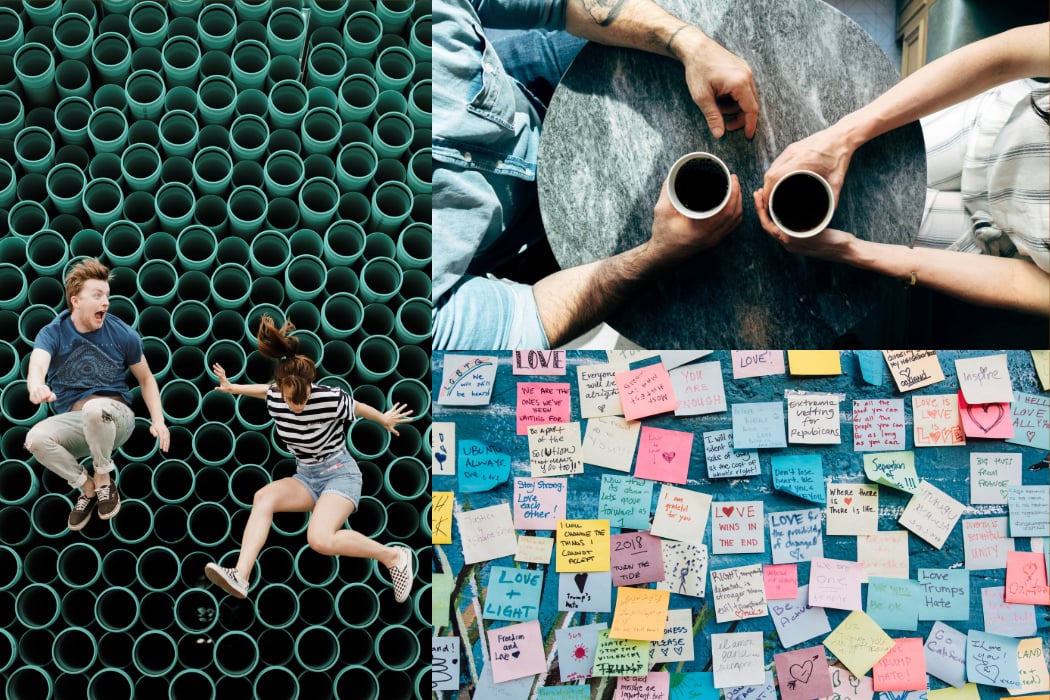
4. Be Eager and Humble
It doesn’t matter how well you do the other 3 things in this list if you do it half-assed or arrogantly. We’ve had volunteers who have landed full-time jobs and have been with us for years, we’ve also had volunteers who were more work than help. Nobody wants to work with somebody who’s not eager to work.
When you’re eager to work, eager to learn and honest about what you don’t know, you start to build an honest relationship with employees of companies you might want to work at. It’s simple: People like people who are eager to help, there’s something about the energy of someone who’s excited about the work they’re doing, even if it’s setting up a workshop table. There’s a tendency with some people to “overcompensate” for their lack of experience by acting uninterested, or even arrogant. This is a major mistake.
When I see somebody doing a half-assed job of a simple task, I don’t think “Oh well, that’s probably just how they deal with boring tasks like this”, I think “Well, that’s how this person is and I don’t want them to infect my teams with this sloppy attitude”.
Conclusion
Ok, I gotta finish this up because it’s getting sloppier the more I write, there are a few more tips I missed in the video above if you’re looking for more. I know I wrote this article with Product Design as the focus, but realistically these tips can be used for any industry.
Click here to read the original write-up by Jonathan Courtney.
Yanko Design Job Board is the best Job Board to connect with great product designers. Post a Job now to reach out to our vibrant following of 2Million+ designers looking for an interesting opportunity!
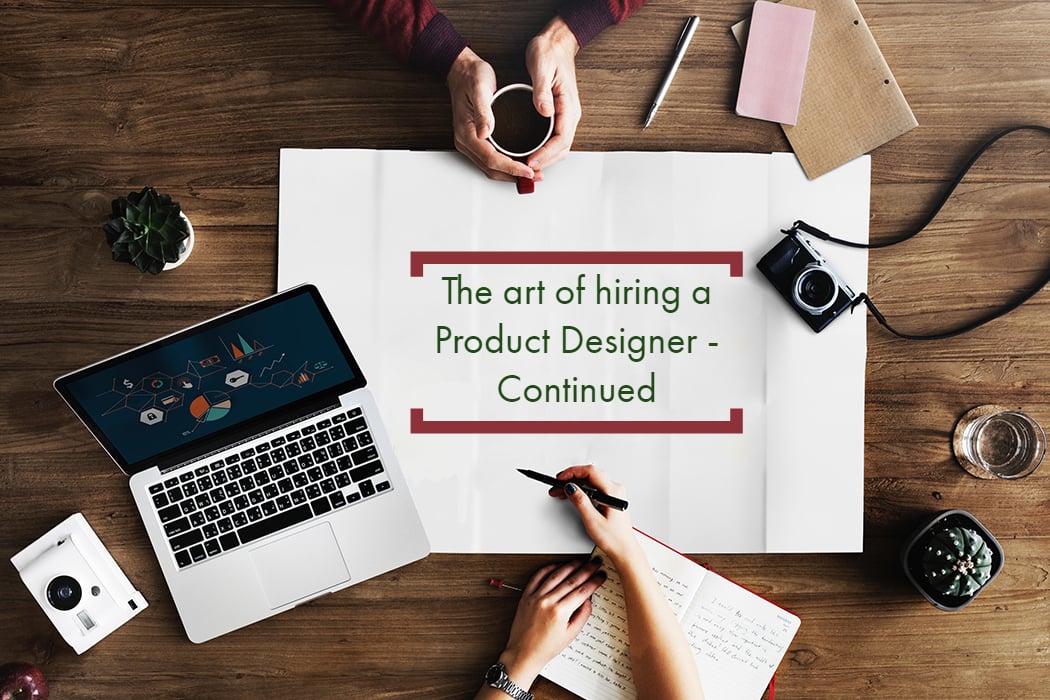 Design and designers are the buzz words in today’s workplace environment. We know that the usual metrics of evaluation for a candidate don’t directly apply to the design demographic. It’s about finding a designer that blends into your work culture and design aesthetics seamlessly.
Design and designers are the buzz words in today’s workplace environment. We know that the usual metrics of evaluation for a candidate don’t directly apply to the design demographic. It’s about finding a designer that blends into your work culture and design aesthetics seamlessly.
P.S. – Recruiting a designer? Yanko Design Job Board will connect you to the designer that integrates with your design sense.
Post a Job now!
The first part of this series spoke about the thought process that changed the way the Buzzfeed office hires designers. The approach they took is personal and involves the designers, which they believe led to better hires. The second part, given below, details the process they followed in vetting the candidate to ensure he is a valuable investment of the time consumed by the process.
Sourcing & Screening
In my previous post I stressed how design has taken ownership of the entire hiring process, from end to end. To get a better understanding of what I’m talking about when I describe “the process”, here’s a diagram of what a candidate would experience when they interview at BuzzFeed:

In this post, we’ll cover the first half of this process: how we find and screen potential candidates.
Sourcing
One of the biggest changes we’ve made in our process is we have stopped publicly posting Product Design job listings on BuzzFeed.com. This may seem counterproductive— after all, BuzzFeed does get a lot of traffic. The problem is that “Product Design” is still a relatively new field, with a title that can be easily misinterpreted for adjacent roles. When we did publicly post listings for Product Design roles on BuzzFeed.com, the majority of the applicants were product managers, marketers, graphic or editorial designers, illustrators, physical product designers, and even mechanical engineers. Digital product designers were a scarce minority, and coming across them in the pool of applicants was much like finding a needle in a haystack. Instead, we recently set-up a casual google form for applicants which can be accessed through Medium, a platform which tends to attract a higher percentage of product designers than our own site.
Aside from the time we save from not having to manage a pool of ineligible applicants, not relying exclusively on external job listings has forced us as designers and design managers to proactively reach out and build up diverse professional networks. We can’t blame it on the pipeline if underrepresented candidates don’t apply to work at BuzzFeed. The onus is on us.
We find many of our prospects through Twitter, Medium, and yes, even Dribbble. For better or worse these sites have a reputation as cesspools of self-promotion, but that’s why they work for sourcing candidates. In fact, all of these platforms have been a more valuable recruiting resource for us than the de facto professional networking site, LinkedIn. While Dribbble offers quick transparency into a designer’s visual chops, Twitter and Medium are where we find written content about a designer’s work. Ideally through these sources we are also able to find a designer’s portfolio in order to get a more in-depth understanding of their process. These artifacts give us more insight into a designer’s thought process, execution, and approach to design than the standard résumé.
We also discover prospects when they’ve engaged thoughtfully with us on any of these platforms.
At BuzzFeed, our internal tools are some of the most impactful products we work on. Designers who expressed either their experience or their interest in tackling these complex workflows got our attention and were added to our list of prospective candidates to reach out to.
Let me illustrate how this proactive approach to recruiting actually increases your reach to potential candidates, compared to a more reactive approach that relies exclusively on incoming applicants:
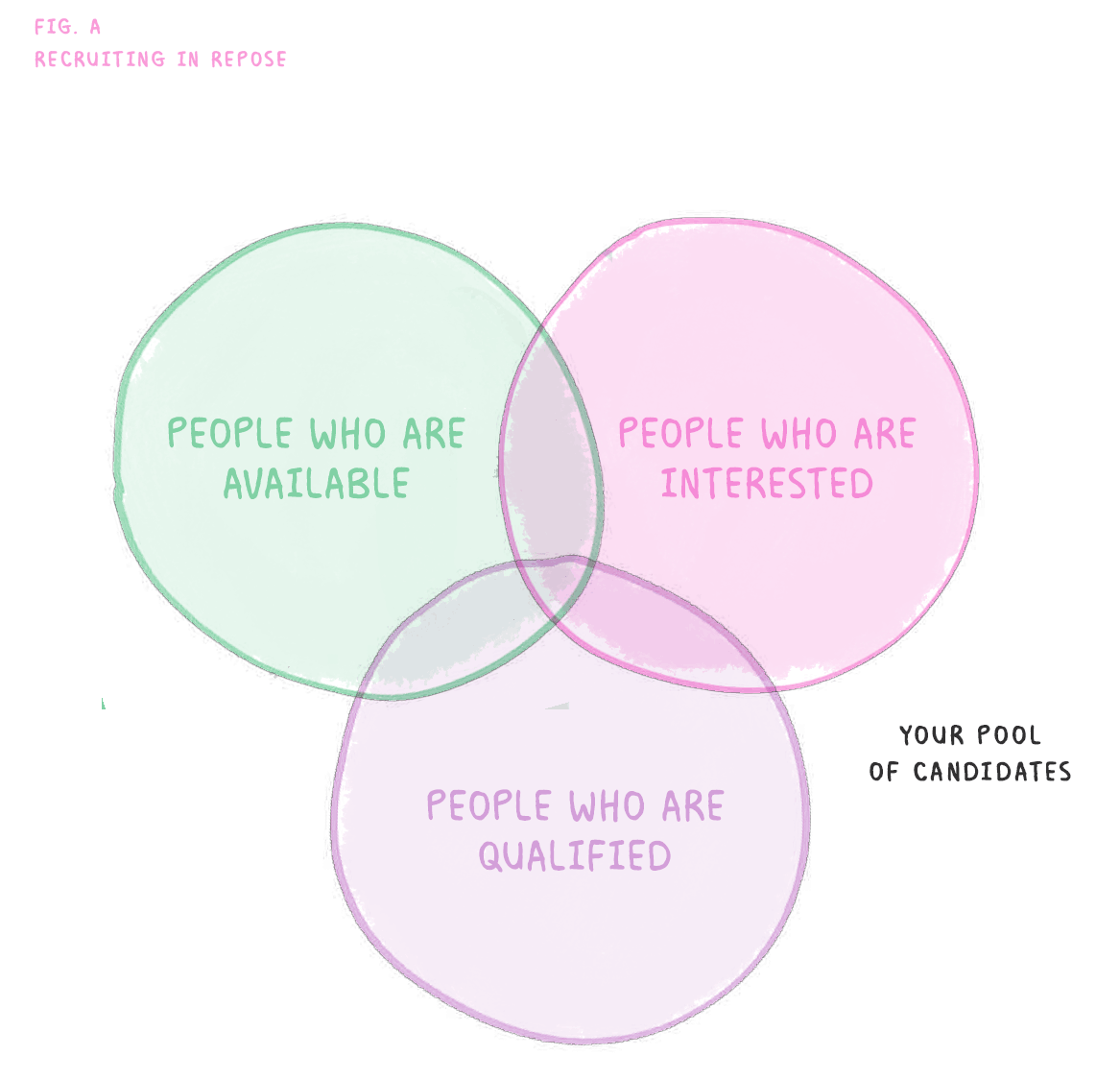
When you rely entirely on incoming applicants, you’re limiting your candidate pool to the small cross-section of people that are qualified, interested, and available. Even if you have a decent number of applicants that meet these criteria, your pool is constrained to the local maxima.
Proactively reaching out to qualified candidates and doing your part to convince them of the reasons why they should be interested is an effective way to grow your base of potential candidates.
This isn’t to say that prospective candidates shouldn’t apply for the jobs they want and instead wait to be reached out to. Personally, I wouldn’t even be at BuzzFeed if not for applying online. It’s also not our intention for it to feel like this job is exclusive to those already within our network— quite the opposite. What we want is to provide prospective candidates direct access and communication to us, the hiring managers for these roles. So if you’re reading this and interested in a design role at BuzzFeed, feel free to directly reach out to me, Cap, Caylee, or Tom. We want to talk to you!
Reaching Out
Honestly, there’s kind of an art to writing emails to prospective candidates that actually earn a response. Especially when reaching out to candidates who aren’t actively looking for a job. Interviewing is often a risky, anxiety-inducing, and vulnerable process. You need to convince someone who is currently in a secure position to take a risk and open themselves up for potential rejection. The best way to do this is by being genuine, detailed, and doing the due diligence of actually learning about them before reaching out.
Let’s look at this recruiting email I recently received as an example:
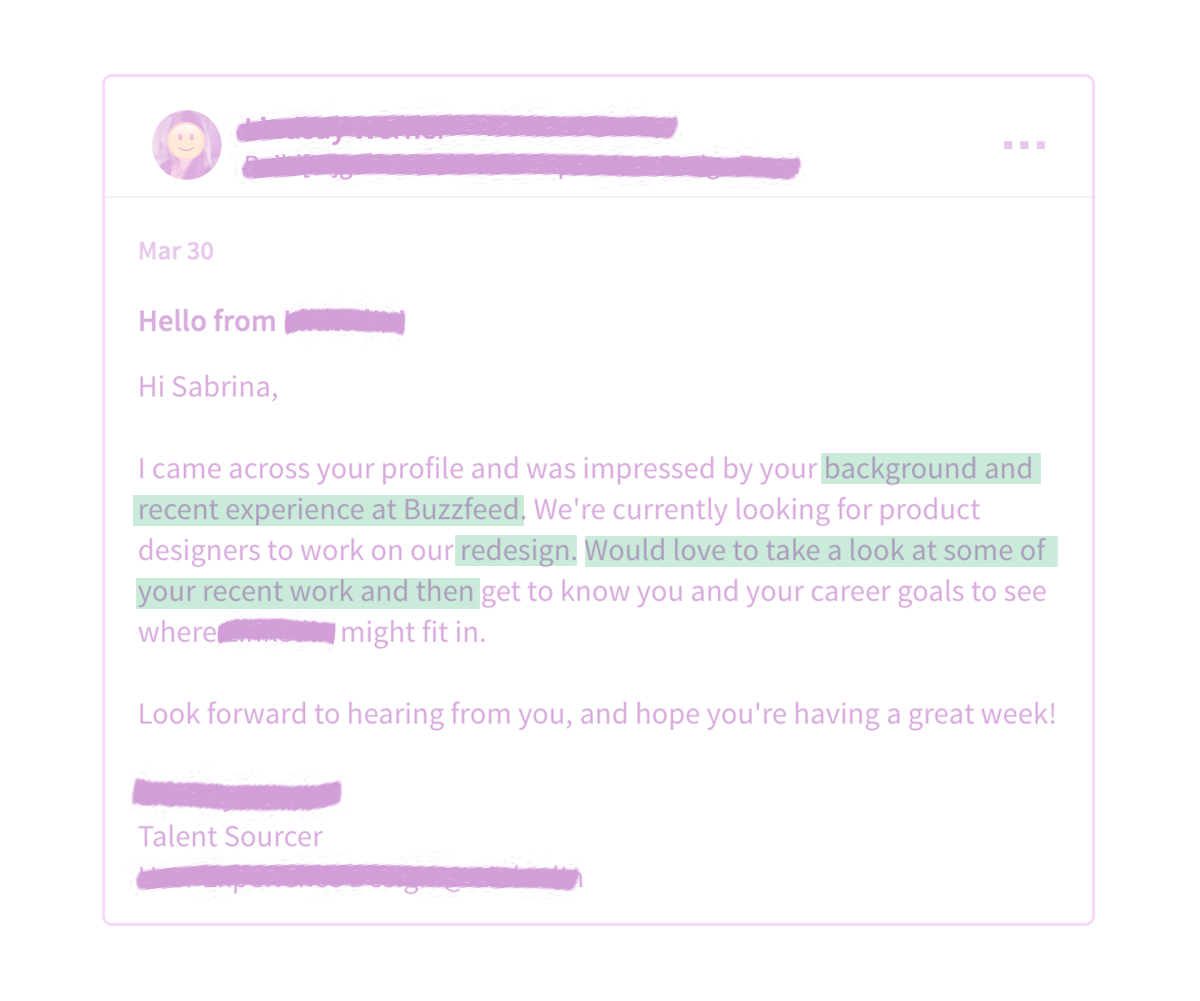
This is by no means a bad email and if I were already interested in the company it could very well work. Assuming I’m not, I’ve highlighted a few areas for improvement. First, the recruiter mentions being impressed by my background and experience at BuzzFeed. My public LinkedIn profile makes it clear that I’ve had recent experience as both an individual contributor designing apps and as a design manager. The lack of specificity here makes me think that the recruiter hasn’t spent much time actually assessing my background. Second, the recruiter mentions a redesign but doesn’t identify what platform or audience the redesign is for. There’s an implied assumption that I’m also familiar with the company’s work. This makes it hard for me to identify if I’m a good fit for the role, or if it’s an area I’d be interested in growing in. Third, instead of offering me a chance to learn more about the role and get the information I need, I am asked to put together work samples to send over for evaluation. For designers who aren’t actively looking, putting together an up to date and well-documented portfolio is a time-consuming process and the recruiter here hasn’t yet convinced me it’s worth the effort.
Here’s how I would have re-written the email:
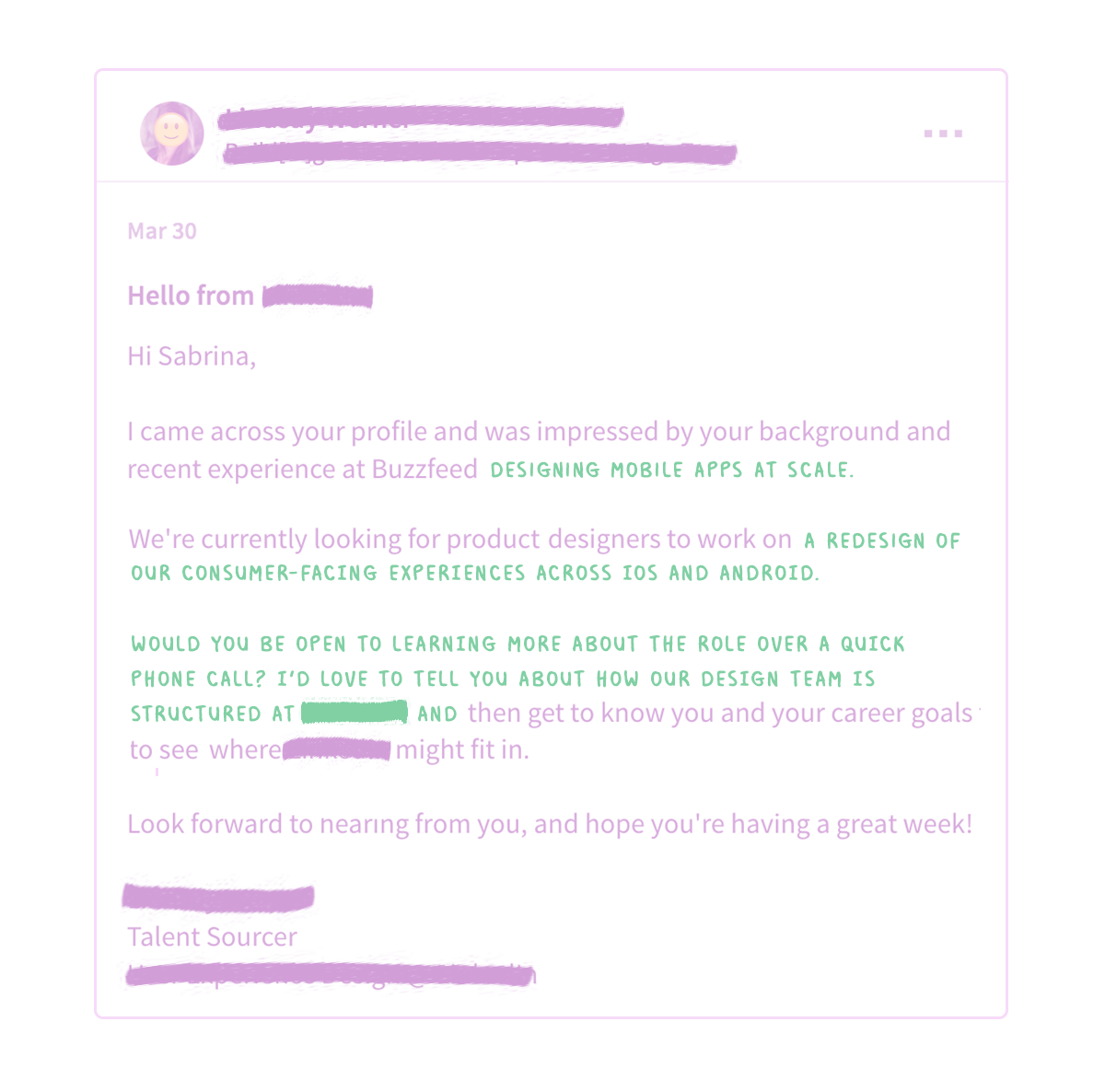
Ideally, what I want to get out of an email like this is a high-level connection between my experience and the company’s current needs and a low-risk opportunity to learn more before deciding to formally pursue the role.
As designers we know that by considering our user’s goals and tailoring experiences around them we can better meet our company or client’s business needs. The same can be applied to recruiting. Be mindful of the candidate’s goals and thoughtful in your communication from the very beginning of the recruiting process to the very end.
Playing The Long Game
I’m of the philosophy that we should always be ‘recruiting’, even if we’re not actively hiring. We don’t need to constantly reach out to individuals or send cold emails, but we should be periodically engaging with the design community. Some examples of how we do this are through hosting meet-ups like Design Driven, open-sourcing our work, and writing about our process. These are all opportunities for us to share both our work and design philosophy with the industry at large, in hopes that it will connect us with like-minded individuals who we could reach out to whenever we need to grow the design team.
If you wait until you have a role that needs filling to take on these types of endeavors, it’s going to take considerably longer before they start working to your advantage. Think of it like an investment. You may not see the return from the first hire, or even the second, but at some point you may notice that more and more people are responding to your cold emails. They’ve heard good things about you, they’re fans of what you’re doing over there, and they want to learn more.

Screening
After we’ve gotten confirmation that a prospect we’ve been talking with is interested in interviewing for the role, the next step involves two screens in order to vet the candidate before bringing them in for an in-person interview loop.
Prior to November, we had been doing a discussion-based “first screen” that focused on teamwork, collaboration, and process. If we felt like the candidate’s approach to design and work was aligned with ours, we would then do a “second screen” in which we ask the candidate to walk us through examples of past work so that we can evaluate their design decisions as well as how they came to those conclusions.
We recently flipped the order of these two screens, after seeing a pattern where many candidates were easily making it from the first screen (“how you work”) to the second (“your work”), but very few were passing the second screen and going onto the on-site interview loop.
While it seemed logical to arrange the screens in order of increasing difficulty, therefore progressing from a more casual conversation to a review that one has to prepare for, our hiring funnel began to look like this:
When ideally, it should be closer to this:
One possible explanation for this pattern is that our “first screens” weren’t thorough enough, and that’s something we’re currently iterating on. The other is that one of these skill sets is more of a pre-requisite than the other, and for a designer, frankly, that’s the ability to execute. If a candidate’s design work doesn’t meet our expectations then ending the conversation there seems like a fairer and more efficient use of everyone’s time.
After we made this change, the initial contrast of seeing so few candidates make it to the second round in the process seemed alarming. Then I realized that before what we were actually seeing was a lot of false positives, and in fact our new process was doing its job in helping us identify the best fits for the roles we were hiring for.
Sometimes, if we feel like we need to gather more information about a candidate, we may ask them to do a take-home design exercise before bringing them in for an interview loop. We compensate people for this exercise and try to pick an abstracted prompt that doesn’t require a lot of internal knowledge. We also try to pick a problem that we aren’t currently thinking about today, as we might then fall into the trap of comparing their solutions to our own. A good example of when we might ask someone to do a design exercise is if we feel they have potential, but their existing work may be impacted by forces outside of their control, such as limited opportunities for design in the company’s process and organization. The design exercise is an opportunity to see how a candidate would approach a problem independently of their current company’s structure.
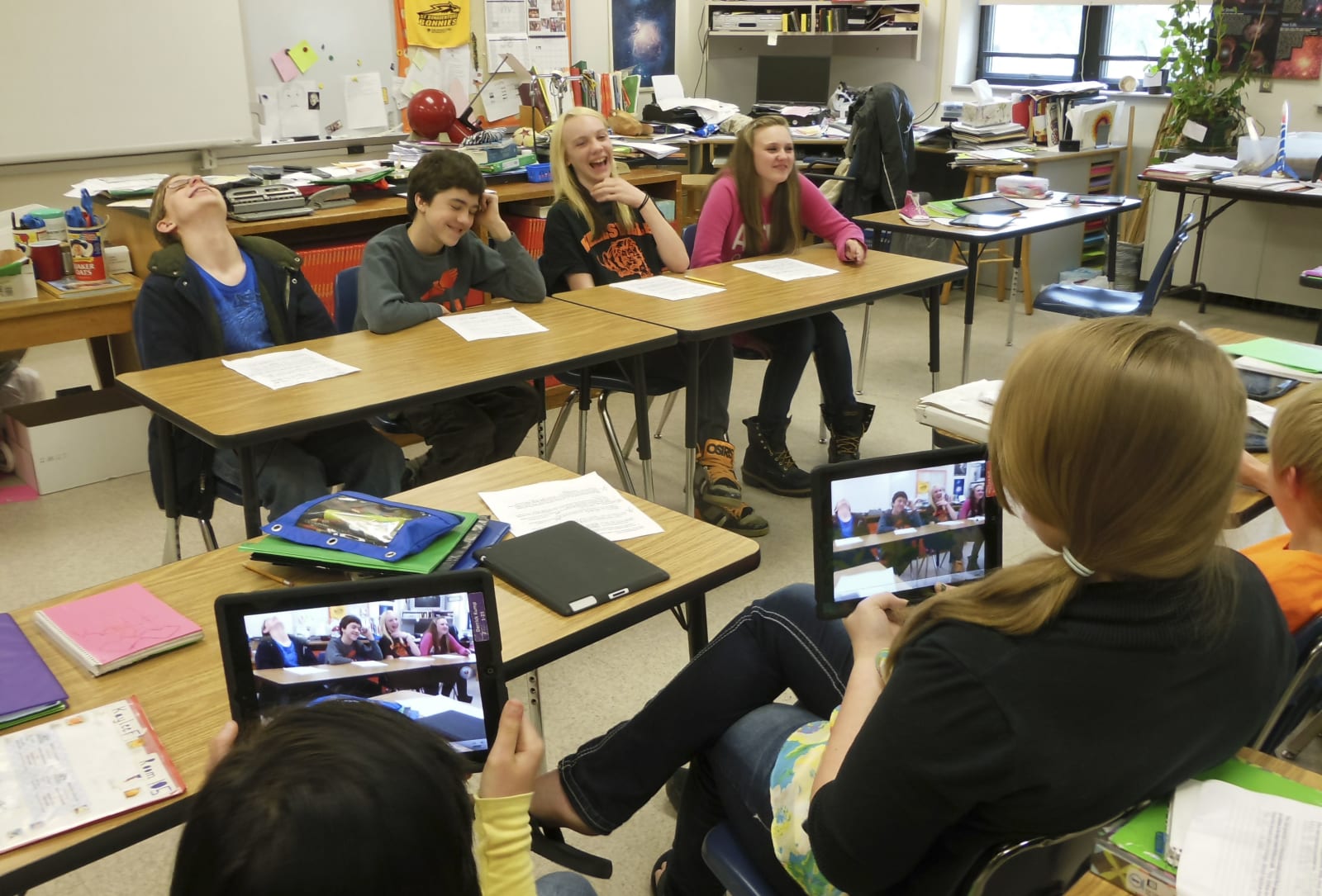 Apple is set to unveil a new low-cost iPad model for educators and students next week, according to Bloomberg's noted Apple reporter Mark Gurman. It's reportedly also working on an educational MacBook model, but won't unveil that until later on. Noth...
Apple is set to unveil a new low-cost iPad model for educators and students next week, according to Bloomberg's noted Apple reporter Mark Gurman. It's reportedly also working on an educational MacBook model, but won't unveil that until later on. Noth...